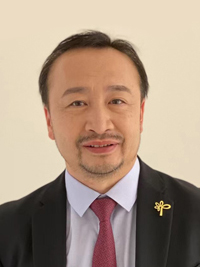Plenary Speakers

Gerd Leuchs
President, OPTICA Director Emeritus, Optics and Information Emeritus Group, Max Planck Institute, GermanyOptics and the Quantum Vacuum

戴聿昌 Yu-Chong Tai
Anna L. Rosen Professor, Electrical Engineering and Medical Engineering, Caltech, USA Academician, Academia Sinica, TaiwanMicro Eye Implants for Intraocular Optics

Jennifer Kehlet Barton
President, SPIE Department of Biomedical Engineering, University of Arizona, USAMiniature endoscope design for early cancer detection

沈平 Ping Shum
President, IEEE Photonics Society Chair Professor, Department of Electronics and Electrical Engineering, Southern University of Science and Technology (SUSTech), ChinaOptical Fiber-Based Technologies & Applications
Optical fiber-based devices have been widely deployed in recent years. There are many advantages of using fiber as a sensor. These include electrically-passive operation, light weight, immunity to radio frequency interference and electromagnetic interference, high sensitivity, compact size, corrosion resistance, easily multiplexing and potentially low cost.
Several novel fiber-based sensors and technologies developed are presented here, including fiber Bragg grating (FBG) based sensors, photonic crystal fiber (PCF) based sensors, specialty fiber-based sensors and distributed fiber sensing systems. FBGs as instinctive sensors, are ingeniously designed as two-dimensional (2D) tilt sensors, displacement sensors, accelerometers and corrosion sensors here; PCF based evanescent field absorption sensor, PCF induced Mach-Zehnder interferometer and Fabry-Perot refractometer for temperature and refractive index sensing are presented; based on localized surface Plasmon resonant (LSPR) effect, nano-sized fiber tip with gold nanoparticles are demonstrated for live cell index bio-sensing applications.

果尚志 Shangjr Gwo
Distinguished Chair Professor, Department of Physics, National Tsing Hua University, Taiwan Convener, Taiwan Quantum Program Office, TaiwanPhotonic and Optoelectronic Device Applications Based on Epitaxial Materials
Prof. Shangjr (Felix) Gwo received his Ph.D. in physics from the University of Texas at Austin, USA in 1993. From 1994 to 1997, he worked in Tsukaba, Japan as a researcher. He joined National Tsing-Hua University (NTHU), Hsinchu, Taiwan as a faculty member in 1997. From 2010 to 2014, he served as the Vice President for Research and Development in NTHU and he is currently a Distinguished Chair Professor of Physics.
Besides his academic career in NTHU, Prof. Gwo served as the Director of National Synchrotron Radiation Research Center (NSRRC) in Hsinchu Science Park, Taiwan from 2014 to 2018. And, from 2019 to 2022, he served as the Director of Research Center for Applied Sciences (RCAS) in Academia Sinica, Nankang, Taiwan. Prof. Gwo's research interests include material physics (semiconductors, metals, and superconductors), nanophotonics, plasmonics, and surface/interface science. Most recently, his research group works extensively on linear and nonlinear plasmonic metasurfaces, two-dimensional materials, plasmonic nanolasers, surface-enhanced Raman spectroscopy, and nitride nanostructure-based light-emitting and detection devices. Prof. Gwo is an elected fellow of the American Physical Society (APS) and the Physical Society of Taiwan.